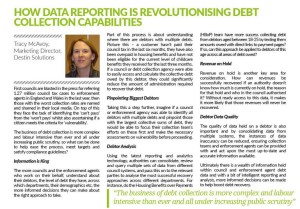First published in Enforcement News on Friday 15th April 2016.
 First Councils are blasted in the press for referring 1.27 million Council Tax cases to bailiffs in England and Wales in the last year, then those with the worst collection rates are named and shamed in their local media. On top of this they face the task of identifying the ‘can’t pays’ from the ‘won’t pays’ whilst also ascertaining if a citizen meets the criteria for ‘vulnerability’.
First Councils are blasted in the press for referring 1.27 million Council Tax cases to bailiffs in England and Wales in the last year, then those with the worst collection rates are named and shamed in their local media. On top of this they face the task of identifying the ‘can’t pays’ from the ‘won’t pays’ whilst also ascertaining if a citizen meets the criteria for ‘vulnerability’.
The business of debt collection is more complex and labour intensive than ever and all under increasing public scrutiny, so what can be done to help ease the process, meet targets and satisfy compliance guidelines?
Information is King
The more Councils and the Enforcement Agents who work on their behalf, understand about their debtors, the level of debt they have, across which departments, their demographics etc, the more informed decisions they can make about the right approach to take.
Part of this process is about understanding where there are debtors with multiple debts. Picture this – a customer hasn’t paid their council tax in the last six months, they have also been overpaid in housing benefits and have not been eligible for the current level of childcare benefits they received for the last 3 months. If a Council or Debt Collection Agency were able to easily access and calculate the collective debt owed by this debtor they could significantly reduce the amount of administration required to recover that debt.
Pinpointing Biggest Debtors
Taking this a step further, imagine if a Council or Enforcement Agency was able to identify all debtors with multiple debts and pinpoint those with the largest collective sums of debt they would be able to focus their collection team’s efforts on these first and make the necessary assessments on vulnerability before proceeding.
Debtor Analysis
Using the latest reporting and analytics technology Authorities can consolidate, review and query multiple sets of data from different Council systems, and pass this on to the relevant parties to analyse the most successful recovery approaches across different departments. For instance, do the HBoP team have more success collecting debt from debtors aged between 18-25 by texting them amounts owed with direct links to payment pages? If so can this approach be applied to debtors of this age across all areas of debt owed?
Revenue on Hold
Revenue on hold is another key area for consideration. How can revenues be successfully recovered if an Authority doesn’t know how much is currently on hold, the reason for that hold and who in the Council authorised it? Without ready access to this data, it makes it more likely that those revenues will never be recovered.
Debtor Data Quality
The quality of data held on a debtor is also important and by consolidating data from multiple systems, the instances of data inaccuracy can be reduced ensuring Collection Teams and Enforcement Agents can be provided with and act upon the most up-to-date and accurate information available.
Ultimately there is a wealth of information held within a Councils and Enforcement Agents debt data and with a bit of intelligent reporting and analysis more informed decisions can be made to help boost debt recovery.
